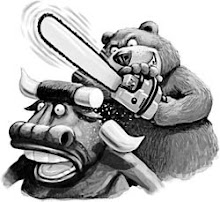The problem with most people, myself included, is that we think statically. For example, I might say "If I save my money some day I will be able to afford to buy a vacation home for cash!" But the world is not a static place, especially these days. My savings may be eroded by inflation or taxes or both or the price of a vacation home may escalate out of reach due to appreciation or taxes or both.
Such is the thinking of those who are convinced that the Fed's expansion of its balance sheet is inflationary. While I don't like Ben Bernanke or his policies and would not trust him as far as I toss a nickel underhand, in a sense he deserves credit for the plan to buy MBS. There are a few dynamics which could work out here. The first is if he is successful in reflating the economy and the asset prices of the houses backing these mortgage securities rises, then these securities could largely be money good and at least to a large extent, be paid back. In this sense this monetary expansion would largely be self-correcting. As these mortgage securities are retired, the excess reserves would be drained from the system, similar to a repo transaction, albeit with a much larger time horizon and of course, without the guaranteed repurchase. If this scenario actually plays out, then one should expect the largest impact of these purchases to be felt up front, with declining effects as these securities mature and are retired.
Now, the real risk in this dynamic is that these purchases are not limited and will be continued beyond their stated expiration. This should not be discounted as the program has already been extended once and political pressures could easily cause it to be extended again. This is the real risk of inflation that we could be facing. But it would require a continued commitment to purchase large quantities of these securities, possibly other junk as well. And the nature of Ponzi finance is such that ever increasing quantities would need to be created and purchased. While this scheme would not be long-term sustainable, it could provide years of positive inflation before leading to a bust of epic proportions. So who would create these securities? And what size would need to be purchased? There may actually be enough of these securities for the Fed to monetize for a few years yet as there is probably $50T plus of debt lying around the globe waiting to go bad. But the $1.2T is really a drop in the bucket. In a $15T US economy, with $150T in US dollars floating around the world with the aforementioned debt, all the Fed may have done would have been to pump up the system by 1-2%. (Yeah, I know all about the multiplier effect, but that is not coming into play, at least not yet, because the private sector is retiring debt not expanding debt.) So the result is basically a wash. Now it is not impossible to see $150 oil, 15,000 on the Dow, Miami condos selling for $500k or more again, but it will not be easy and it will take a helluva lot more than $1.2T. Try $10T or $20T over the next 3-5 years. Although, Helicopter Ben is crazy, is he really that crazy? And moreover, would the rest of us sit by silently and watch such insanity? We are already close to the point where new debt is actually destructive as the service costs eat up a prohibitive amount of income. A gradual scaling back of MBS purchases by the Fed could lead to a slow collapse, while a rapid expansion would likely eventually lead to a violent failure of epic proportions. While it is hard to envision the latter, we must always be aware and on the look out.




